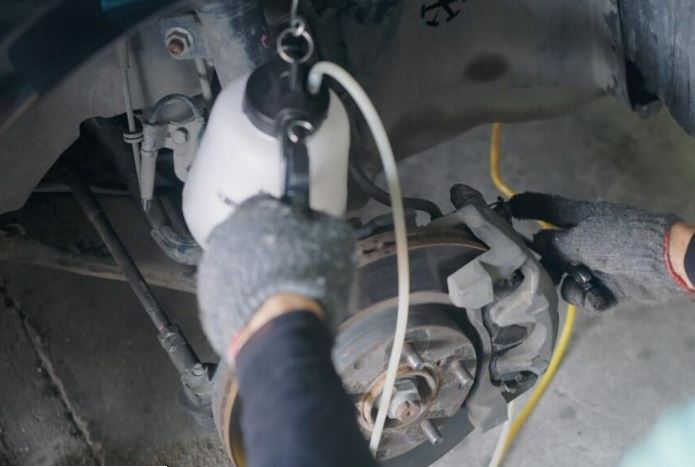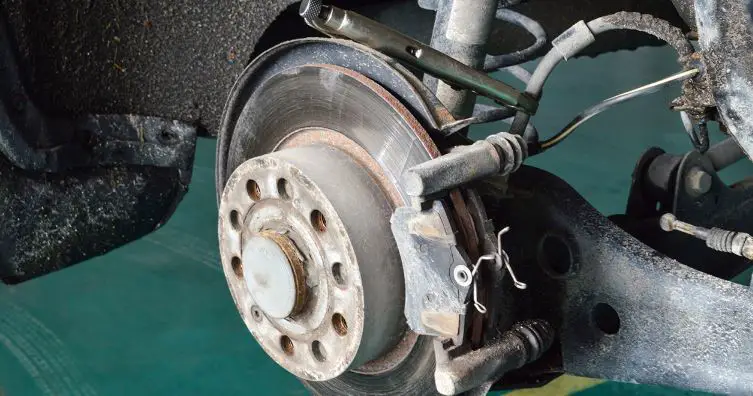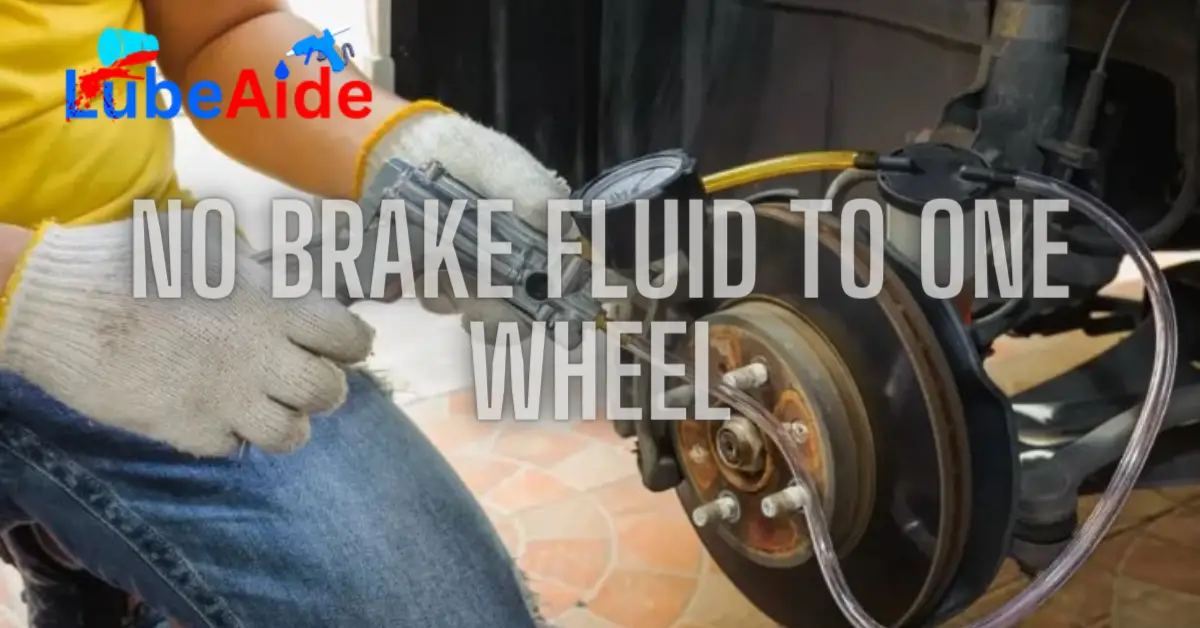When driving a vehicle, it’s crucial to ensure that all the brakes are working correctly. However, if you notice that one wheel is not getting any brake fluid, it’s a cause for concern. This issue can lead to uneven braking, which can cause accidents.
There are several reasons why a wheel may not be getting brake fluid. One of the most common reasons is a damaged brake line. If the brake line leading to the wheel is damaged or has a leak, it can cause a loss of brake fluid. Another reason could be a malfunctioning brake caliper, which is responsible for applying pressure to the brake pads. If the caliper is not functioning correctly, it can cause the brake pads to wear unevenly and cause a decrease in braking power.
Symptoms

When there is no brake fluid reaching one wheel, there are several symptoms that can indicate the problem. These symptoms can vary depending on the severity of the issue and the type of vehicle in question. Here are some common symptoms:
Vehicle Pulls to One Side
One of the most noticeable symptoms of no brake fluid to one wheel is the vehicle pulling to one side. This occurs because the brake on one side of the vehicle is not working properly, causing the vehicle to veer in that direction. This can be dangerous, especially at high speeds or when driving on uneven roads. If the vehicle pulls to one side while braking, it is important to have the brakes checked immediately.
Spongy or Soft Brake Pedal
Another symptom of no brake fluid to one wheel is a spongy or soft brake pedal. When there is not enough brake fluid reaching the brake caliper, the brake pedal may feel soft or spongy when pressed. This can make it difficult to stop the vehicle quickly and can be a safety hazard. If the brake pedal feels spongy or soft, it is important to have the brakes checked as soon as possible.
Brake Warning Light On
The brake warning light on the dashboard is designed to alert the driver to any issues with the braking system. If the brake warning light comes on, it could indicate that there is no brake fluid reaching one wheel. This could be due to a leak in the brake line or a faulty brake caliper. It is important to have the brakes checked immediately if the brake warning light comes on.
In summary, symptoms of no brake fluid to one wheel include a vehicle pulling to one side, a spongy or soft brake pedal, and a brake warning light on the dashboard. If any of these symptoms are present, it is important to have the brakes checked as soon as possible to ensure safe driving.
Causes

Leaking Brake Line or Hose
One of the most common causes of no brake fluid to one wheel is a leaking brake line or hose. This can happen due to wear and tear, corrosion, or damage from road debris. A brake line or hose leak can cause a loss of pressure in the brake system, which can result in reduced braking power or complete brake failure.
Faulty Brake Caliper or Wheel Cylinder
Another possible cause of no brake fluid to one wheel is a faulty brake caliper or wheel cylinder. These components are responsible for applying pressure to the brake pads or shoes, which in turn slows down the wheel. If a caliper or wheel cylinder is malfunctioning, it may not apply enough pressure to the brake pad or shoe, resulting in reduced braking power or complete brake failure.
Master Cylinder Failure
A third possible cause of no brake fluid to one wheel is master cylinder failure. The master cylinder is responsible for distributing brake fluid to all four wheels. If the master cylinder fails, it can result in a loss of pressure in the brake system, which can cause reduced braking power or complete brake failure.
In conclusion, there are several possible causes of no brake fluid to one wheel. These include a leaking brake line or hose, faulty brake caliper or wheel cylinder, and master cylinder failure. It is important to have your brakes inspected regularly to ensure that they are functioning properly and to address any issues as soon as they arise.
Diagnosis
When faced with a brake system issue, it is crucial to diagnose the problem accurately. A brake system that fails to deliver the required stopping power can be a safety hazard for the driver and other road users. If a vehicle has no brake fluid to one wheel, the following diagnostic procedures can be conducted:
Visual Inspection
The first step in diagnosing a brake system issue is to visually inspect the brake system components. A visual inspection can help identify any visible leaks, damaged brake lines, or worn-out components. The following components should be inspected:
- Brake pads and shoes
- Brake calipers and wheel cylinders
- Brake rotors and drums
- Brake lines and hoses
- Brake master cylinder
If any of these components are damaged, worn out, or leaking, they should be replaced immediately.
Brake Fluid Pressure Test
A brake fluid pressure test can help identify any issues with the brake system’s hydraulic pressure. A pressure gauge is connected to the brake system, and the brake pedal is pressed to measure the pressure. If the pressure is low, it may indicate a leak in the brake system or a problem with the brake master cylinder.
Brake Line and Hose Inspection
The brake lines and hoses transport brake fluid to the brake system components. A damaged or leaking brake line or hose can cause a loss of brake fluid to one wheel. A thorough inspection of the brake lines and hoses can help identify any leaks or damage. If any brake lines or hoses are damaged, they should be replaced immediately.
In conclusion, diagnosing a brake system issue accurately is crucial to ensure the safety of the driver and other road users. A visual inspection, brake fluid pressure test, and brake line and hose inspection can help identify any issues with the brake system. Any damaged or worn-out components should be replaced immediately to ensure the brake system’s proper functioning.
Repair
Replace Brake Line or Hose
If the brake line or hose is damaged, it will need to be replaced. This can be done by following these steps:
- Locate the damaged brake line or hose.
- Remove the damaged line or hose.
- Install the new brake line or hose.
- Bleed the brake system to remove any air.
Replace Brake Caliper or Wheel Cylinder
If the brake caliper or wheel cylinder is not working properly, it will need to be replaced. Here are the steps to replace it:
- Remove the old brake caliper or wheel cylinder.
- Install the new brake caliper or wheel cylinder.
- Bleed the brake system to remove any air.
Replace Master Cylinder
If the master cylinder is not working properly, it will need to be replaced. Here are the steps to replace it:
- Remove the old master cylinder.
- Install the new master cylinder.
- Bleed the brake system to remove any air.
It is important to note that if one wheel is not getting brake fluid, it may be a sign of a larger issue with the brake system. It is recommended to have a professional mechanic inspect the system to ensure it is functioning properly.
FAQs About No Brake Fluid to One Wheel
What are the signs of having no brake fluid to one wheel?
Signs of no brake fluid reaching one wheel may include reduced braking performance on that specific wheel, uneven braking, the vehicle pulling to one side during braking, or a spongy brake pedal.
Can I still drive my car if there is no brake fluid to one wheel?
Driving a vehicle with no brake fluid reaching one wheel is highly unsafe and should be avoided. It can lead to compromised braking ability, increased stopping distances, and potential loss of control.
How do I check if there is no brake fluid to one wheel?
To check for the absence of brake fluid to one wheel, you can perform a visual inspection for leaks or wet spots around the affected wheel, inspect the brake fluid level in the reservoir, and observe any abnormal braking behavior, such as reduced effectiveness or pulling to one side.
What should I do if I discover there is no brake fluid to one wheel?
If you determine that there is no brake fluid reaching one wheel, it is crucial to address the issue promptly. Consult a qualified mechanic to diagnose the cause and carry out the necessary repairs or replacements to restore proper brake fluid flow.
How much does it cost to fix a problem with no brake fluid to one wheel?
The cost of fixing a problem with no brake fluid to one wheel can vary depending on the underlying cause and the specific repairs needed. Costs may include replacement of brake lines, hoses, calipers, wheel cylinders, or the master cylinder, as well as labor charges. It is best to consult a mechanic for an accurate cost estimate.
Is it possible to fix the issue of no brake fluid to one wheel myself?
Repairing the issue of no brake fluid to one wheel often requires professional expertise and specialized tools. It is generally recommended to seek assistance from a qualified mechanic who can diagnose the problem accurately and perform the necessary repairs to ensure your safety on the road.
Can air in the brake system cause no brake fluid to one wheel?
Yes, air trapped in the brake system can cause a loss of brake fluid to one wheel. Air bubbles can prevent the proper distribution of brake fluid, resulting in reduced or no braking ability on that specific wheel. Brake bleeding is often necessary to remove air from the system.
How long does it take to fix a problem with no brake fluid to one wheel?
The time required to fix a problem with no brake fluid to one wheel depends on the specific cause and the extent of repairs needed. It can range from a few hours to a full day, depending on the complexity of the issue and the availability of parts.
Final Thought
In the end, the absence of brake fluid reaching one wheel is a concerning issue that requires attention. Several causes can contribute to this problem, including brake line blockages, brake caliper or wheel cylinder failures, master cylinder issues, or brake fluid leaks. Diagnosing the specific cause may involve visual inspections, checking the brake fluid level, performing a brake bleeding procedure, and seeking professional assistance if needed.
Resolving the issue involves addressing the underlying cause. This can include clearing blockages, repairing or replacing malfunctioning brake components, fixing leaks in the brake system, or seeking professional help for a thorough diagnosis and repair. Prompt action is crucial as driving with compromised braking on one wheel can pose safety risks, such as uneven braking and reduced stopping efficiency.
Related Topics:
- why does my oil light come on when i brake
- What Can I Use Instead of Brake Fluid
- Can You Use Transmission Fluid for Brake Fluid
- Is It Necessary to Change Brake Fluid Every Two Years
- How to Dispose of Brake Fluid
- Does Brake Fluid Leak When Car is Off
- Brake Fluid vs Transmission Fluid
- Brake Fluid Leaking from Caliper Bolt
- When to Flush Brake Fluid
- can you add brake fluid while car is hot


